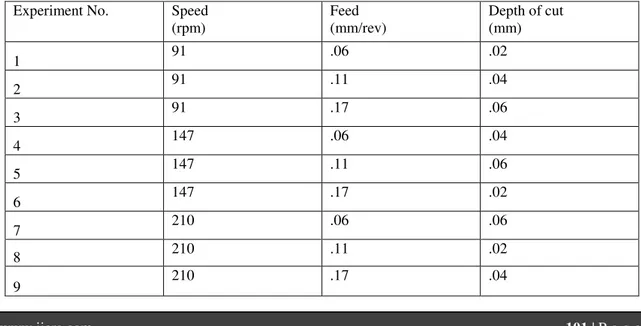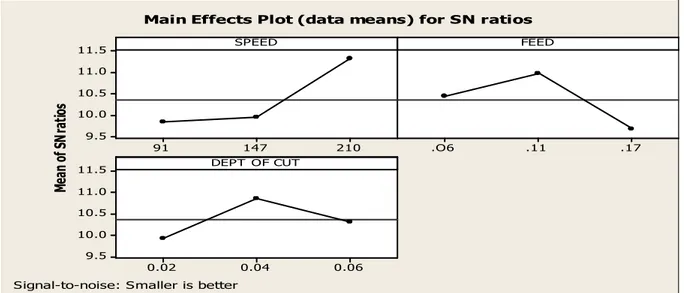Optimization of Cylindrical Grinding Process Parameters on
C40E Steel Using Taguchi Technique
*Naresh Kumar, **Himanshu Tripathi, ***Sandeep Gandotra
*Assistant Professor, Department of Mechanical Engineering, Arni University, Kathgarh, Himachal Pradesh, India
**Assistant Professor, Department of Mechanical Engineering, Global Institute of Engineering and Technology, Amritsar, Punjab, India
***Assistant Professor, Mechanical Engineering Department, Beant College of Engineering and Technology Gurdaspur, Punjab, India
ABSTRACT
: Surface finish and dimensional accuracy play a vital role in the today’s engineering industry. There are several methods used to achieve good surface finish like burnishing, honing and lapping, and grinding. Grinding is one of these ways that improves the surface finish and dimensional accuracy simultaneously. C40E steel has good industrial application in manufacturing of shafts, axles, spindles, studs, etc. In the present work the cylindrical grinding of C40E steel is done for the optimization of grinding process parameters. During this experimental work input process parameters i.e. speed, feed, depth of cut is optimized using Taguchi L9 orthogonal array. Analysis of variance (ANOVA) concluded that surface roughness isminimum at the 210 rpm, 0.11mm/rev feed, and 0.04mm depth of penetration.
KEYWORDS
: Cylindrical Grinding, Speed, Feed, Depth of Cut.I.
INTRODUCTION
Grinding is the machining processes which improve surface quality and dimensional accuracy of the workpiece. Various process parameters, which affect the cylindrical grinding operation are depth of cut, material hardness, workpiece speed, grinding wheel grain size, number of passes, material removal rate and grinding wheel speed. Speed and feed are critical factors because increasing the both speed, and feed has an adverse impact on surface roughness but high material removal cause reduction in surface roughness [1]. Rise in infeed, cross feed, and grinding speed showed improvement in surface hardness and surface roughness on En18 steel [2]. Authors found that the depth of cut and workpiece speeds are significant parameters. Depth of cut among these factors found more important whereas the grinding speed, grain size, cutting fluid concentration and number of passes are considered insignificant while grinding heat treated AISI 4140 steel [3].The parameters like coolant inlet pressure, grinding wheel speed, and table speed and nozzle angle showed a positive effect on the microhardness of the finished mild steel workpiece [4].Cutting fluid like water soluble oil gives better surface finish than pure oil used because the water mixed oil has a lesser viscosity and more flow rate which results smoothing action while grinding En8 steel [5]. The parameters like feed rate, depth of cut and grit size is the primary influencing factors that affect the surface integrity of silicon carbide while grinding. Authors suggested that with an increase in feed rate, the
percentage area of surface damage decreases and is minimally affected by the variation in grit density, within the range considered [6]. The usage of pure oil reduces the grinding force, specific energy, acoustical emission and roughness values. These characteristics result from the high lubricating power of pure oil, which decreases the friction and reduces the generation of heat in the grinding zone. Therefore, pure oil used as a grinding fluid to obtain high-quality superficial dressing and lower tool wear is the best choice for industrial applications [7].
II.
OBJECTIVE OF PRESENT
INVESTIGATION
To investigate and optimize the grinding process parameters (speed, feed and depth of cut) for the enhancement of surface finish on C40E steel.
III.
EXPERIMENTATION
The workpiece material C40E steel is selected as the workpiece material having diameter 40 mm and length 380 mm. This steel is widely used in industrial application like shafts, axles, spindles, studs, etc. for its excellent mechanical properties. The chemical composition of C40E steel is shown in Table1. The workpiece material is cut into pieces each having approximate length of 380 mm. The workpiece is turned to a diameter of 38 mm using lathe, and the workpiece was divided into four equal parts of 65 mm each as shown in Figure1. The surface roughness of the workpiece is measured before grinding at each
Figure2. To minimize the chance of error, three reading have been taken for each set and the average
value of three reading is used for record.
Table 1 Chemical Composition (in weight %)
Figure 1 Workpiece preparation The grinding operation is performed after turning
process on the workpiece. HR-450 MM grinding machine is used for the experimentation. The parameters like speed of the workpiece, feed rate and depth of cut is used as input parameters. Other parameters such as grinder speed and condition of grinding (wet condition) were kept constant. The
surface roughness is taken as the response parameter. Assigned values of input machining parameters at different levels and their designation are tabulated in Table 2. Taguchi design of experiment is used for optimizing the input parameters using l9 orthogonal
array which has been presented in Table 3.
Table 2 Assigned values of input machining parameters at different levels and their designation
Table 3 Design Matrix of L9 (33) orthogonal array
Carbon (C)
Silicon (Si)
Manganese (Mn)
Phosphorous (P)
Sulphur (S)
Chromium (Cr)
Molybdenum (Mo)
.40-.45 .10-.40 .70-.90 .05 max .05 max --- ---
Factor Designation
Parameters (units) Levels and corresponding values of Machining parameter
Level-1 Level2 Level3
A Speed (rpm) 91 91 91
B Feed (mm/rev) 0.06 0.06 0.06
C Depth of cut (mm) 0.02 0.02 0.02
Experiment No. Speed (rpm)
Feed (mm/rev)
Depth of cut (mm)
1 91 .06 .02
2 91 .11 .04
3 91 .17 .06
4 147 .06 .04
5 147 .11 .06
6 147 .17 .02
7 210 .06 .06
8 210 .11 .02
IV.
RESULTS AND DISCUSSIONS
IV.1. Surface roughness: Surface roughness after cylindrical grinding is measured by using Mitutoyo - Surftest SJ-210 surface roughness tester. Three reading are taken in each region, and the average of them were taken to minimize the error. Figure 2
shows the Mitutoyo - Surftest SJ-210 surface roughness tester which is used for measurement if surface roughness. The experimental results for surface roughness obtained using Taguchi optimization technique are given in Table 4.
Figure 2 Mitutoyo - Surftest SJ-210 surface roughness tester Table 4 Experimental results for surface roughness
Experiment no.
Workpiece Speed (rpm)
Feed (mm/rev)
Depth of cut (mm)
Surface Roughness(µm) Mean(µm) SNRA
Trial1 Trial2 Trial3
1 91 .06 .02 0.248 0.441 0.327 0.338667 9.1732
2 91 .11 .04 0.257 0.255 0.238 0.250000 12.0362
3 91 .17 .06 0.344 0.425 0.382 0.383667 8.2887
4 147 .06 .04 0.319 0.375 0.279 0.324333 8.2887
5 147 .11 .06 0.327 0.242 0.346 0.305000 10.2196
6 147 .17 .02 0.277 0.292 0.381 0.316667 9.8977
7 210 .06 .06 0.248 0.223 0.245 0.238667 12.4347
8 210 .11 .02 0.256 0.235 0.368 0.286333 10.6857
9 210 .17 .04 0.301 0.265 0.295 0.287000 10.8293
IV.2. Analysis of Variance: The results for surface roughness (SR) are analyzed using ANOVA in Minitab 17 software. The criterion for evaluation, "smaller is better" is used. For high surface finish, the value of surface roughness should be minimum. Table 5 summarizes the information for analysis of variance and case statistics for further interpretation. Smaller is better S/N = -10 log [1/n (Σyi2)] (n=1)
ANOVA Table 5 for Surface Roughness clearly indicates that the grinding speed and feed is more
Table 5 Analysis of Variance for means of SN ratio for Surface Roughness (Smaller is Better)
Source DF Seq SS Adj SS Adj MS F P Percentage Contribution
Speed 2 6.197 6.197 3.0985 17.6051136 0.584 44.95
Feed 2 4.795 4.795 2.3975 13.6221591 0.689 34.78
Depth of cut 2 2.442 2.442 1.221 6.9375 0.811 17.71
Residual error 2 0.352 0.352 0.176 2.55
Total 8 13.786 100.00
Figure3 Percentage contribution of parameters towards surface roughness Table 6 Response Table for Signal to Noise Ratios (Smaller is better)
Level Speed Feed Depth of cut
1 9.833 10.442 9.919
2 9.945 10.980 10.861
3 11.317 9.672 10.314
Delta 1.484 1.309 0.942
Rank 1 2 3
Figure 4 indicates the main effect plots for the surface roughness which shows very clearly that the 3rd level of workpiece speed (210 rpm), 2nd level of feed (11mm/rev) and 2nd level of depth of cut (0.04 mm) are the optimum values of process parameters for the surface roughness. The level and the values at which surface roughness is minimum has been obtained are given in Table7.
M
ea
n
of
S
N
ra
tio
s
210 147
91 11.5
11.0
10.5
10.0
9.5
.17 .11
.O6
0.06 0.04
0.02 11.5
11.0
10.5
10.0
9.5
SPEED FEED
DEPT OF CUT
Main Effects Plot (data means) for SN ratios
Signal-to-noise: Smaller is better
Figure 4 Main effects plot for means SN ratios (Surface Roughness) 0.00
10.00 20.00 30.00 40.00 50.00
1
2
3
4 Speed
44.95% Feed 34.78%
Depth of cut 17.71
Table 7 Levels and values of input parameters at minimum Surface Roughness
Factor Speed(rpm) Feed(mm/rev) Depth of cut(mm)
Level 3 2 2
Values 210 .11 .04
IV.4 Confirmation of experiment: Predicted values of means were investigated using confirmation test. The experimental values and predicted values are given in Table 8. Since the error between experimental and predicted value is 3.0 % so the experimental work is said to be satisfactory.
Table 8 Confirmation test result and comparison with predicted result as per model
V.
CONCLUSIONS
Based on the analytical and experimental results obtained in this study following conclusions can be drawn.
1. The input parameters like speed of grinding, feed, has a significant effect on surface roughness, whereas depth of cut has the least effect on surface roughness of C40e steel. 2. The optimized parameters for minimum surface
roughness are grinding speed (210 rpm), feed (0.11 mm/rev), and depth of cut (0.04mm). 3. The optimized minimum surface roughness is
0.238 µm that is about 78% of the initial value.
REFERENCE
[1] M. Kiyak, O. Cakir, and E. Altan, “A Study
on Surface Roughness in External
Cylindrical Grinding”, International
Scientific conference on Achievements in Mechanical & Material Engineering, Polish academy of Science - a Committee of Material Science, Silacian University of Technology of Gliwice.
[2] K. Paland V. Shivhare, “The Influence of Cutting Parameter of Surface Grinder on the Surface Finishing and Surface Hardness of Structural Steel”, International Journal of Basic and Applied Science Research (IJBASR) ,Vol.1, No. 1, December, 2014, pp.11-14.
[3] K. Singh, P. Kumar, and K. Goyal, “To Study the Effect of Input Parameters on Surface Roughness of Cylindrical Grinding of Heat Treated AISI 4140 Steel”, American
Journal of Mechanical Engineering, Vol. 2, No. 3, 2014, pp.58-64.
[4] B. Singh, and B. Singh, “Effect of Process Parameters on Micro Hardness of Mild Steel Processed by Surface Grinding Process”, Journal of Mechanical and Civil Engineering , Vol. 10, Issue 6, 2014, pp. 61-65.
[5] P. S. Thakor, and D. M. Patel, “An Experimental Investigation on Cylindrical Grinding Process Parameters for En 8 Using Regression Analysis”, International Journal of Engineering Development and Research,Vol. 2, Issue 2, 2014, pp.2486-2491.
[6] A. V. Gopal, and P. V. Rao, “Selection of optimum conditions for maximum material removal rate with surface finish and damage
as constraints in SiC grinding”,
International Journal of Machine Tools & Manufacture, Vol. 43, 2003, pp. 1327-1336 [7] E. C. Bianchi, C. G. Franzo, P. R. de
Aguiar, and R. E. Catai, “Analysis of the Influence of Infeed Rate and Cutting Fluid on Cylindrical Grinding Processes Using a Conventional Wheel”, Materials Research, Vol. 7, No. 3, 2004, 385-392,
Output Parameter
Experimental value
Predicted value
%age Error



